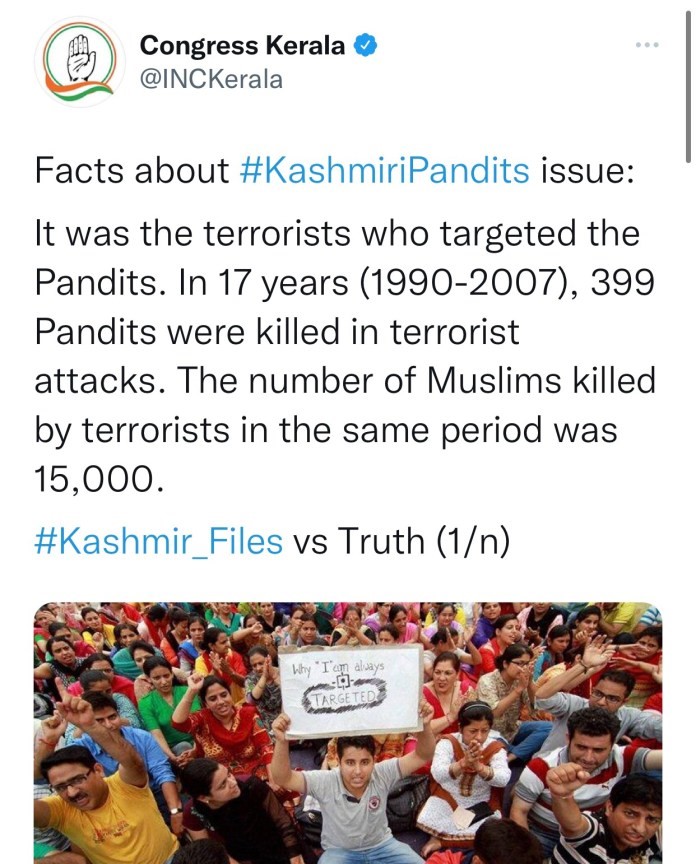The following article was written for MyInd Makers. Pasting it here for reference:
The Kerala Congress twitter handle has been on a rampage in the last couple of days. Actually, let’s not fool ourselves. The Kerala Congress twitter handle is just a messenger. The message is coming right from the top. The most vocal amongst the top three in the Congress party is the crown prince, Rahul Gandhi. So, for the sake of arguments in this article, we can safely assume that it is Rahul Gandhi whose thoughts have been expressed by the Kerala Congress twitter handle. Rahul Gandhi did two twitter threads in a matter of 2 days – astonishingly absurd arguments were presented in the first one and even worser justifications of the first thread were written in the second one.

The timeline Rahul Gandhi chose to highlight -1990 to 2007 – in his now deleted first tweet in the first thread, is very intriguing. I am still not able to understand why he chose this particular period of 17 years. Rahul Gandhi has given us an exact number – 399 – of Kashmiri Pandits who were killed (according to him). But gives a round figure of 15,000 for Muslims! He claims that 15,000 Muslims were killed by terrorists in this time period. Does he mean that these killings happened only in Kashmir? Or was he referring to the entire country? There is absolutely no report, official or otherwise, that claims that 15,000 Muslims were killed by terrorists between 1990 to 2007, either only in Kashmir or in the whole of India. His party was in power for 10 out of these 17 years he chose to mention here, so is he now alluding that his party was majorly responsible for loss of 15000 lives? Like many things Rahul Gandhi does, this tweet also didn’t make any logical sense.
In his second tweet of the second tweet thread, he makes a startling revelation that “Congress bought peace & rehabilitated victims”. Now I am confused. According to Rahul Gandhi’s now deleted tweet, terrorists killed 15399 people from 1990 to 2007. How does that amount to bringing peace? Since the year 2008, stone pelting was a regular occurrence in Kashmir. We all remember the mayhem of the year 2010 when there were “Go back, India” slogans written on the roads of Kashmir; when alleged students were encouraged to call the violence as an “Anti-India movement” and be proud about it.
We all remember the wise words of then Home Minister, P. Chidambaram, who said “You pelt stones, make security personnel targets, burn government property and expect us to remain silent and do nothing?" How does all of this amount to bringing peace? Did Rahul Gandhi really want us to forget things that happened after 2007 under his government’s watch?
He also claims that “For Congress, it's a long battle between separatists & those who stand with India.” We must thank his highness Shri Rahul Gandhi for acknowledging the “long battle”. He should now enlighten us as to why the battle has been a long one. Is it because his family was busy developing friendship with the very same separatist mindset people that the tweet mentions? Is it because his family has nurtured the seeds of separatism by introducing Article 370? And while the “long battle” was going on, why was the face of the separatists given an audience with none other than the Prime Minister of India? Rahul Gandhi wanted to make the “long battle” sound like an achievement of his without realizing that it the failing of his family that led to nightmares to the Kashmiri people.
Through his tirade of tweets, Rahul Gandhi wanted us to believe that everything was all rosy till January 19th, 1990. He wants us to believe that Farrukh Abdullah resigned just out of fun, and when Jagmohan was appointed as Governor on 21st January, all Kashmiri Pandits decided to pack up and leave Kashmir. There are multiple sites that provide a better accurate timeline of the simmering tensions in the valley during Rajiv Gandhi’s reign and how they peaked during January 1990, so we will not get into those details in this article.
Many have often made this point that Rahul Gandhi is very dangerous to the integrity of our country. He is not as naïve as people think he is. What seem as disjoint and disoriented thoughts are often born out of the urge to create divisions in the Indian society. The tweet threads have further reinforced this image of Rahul Gandhi.
